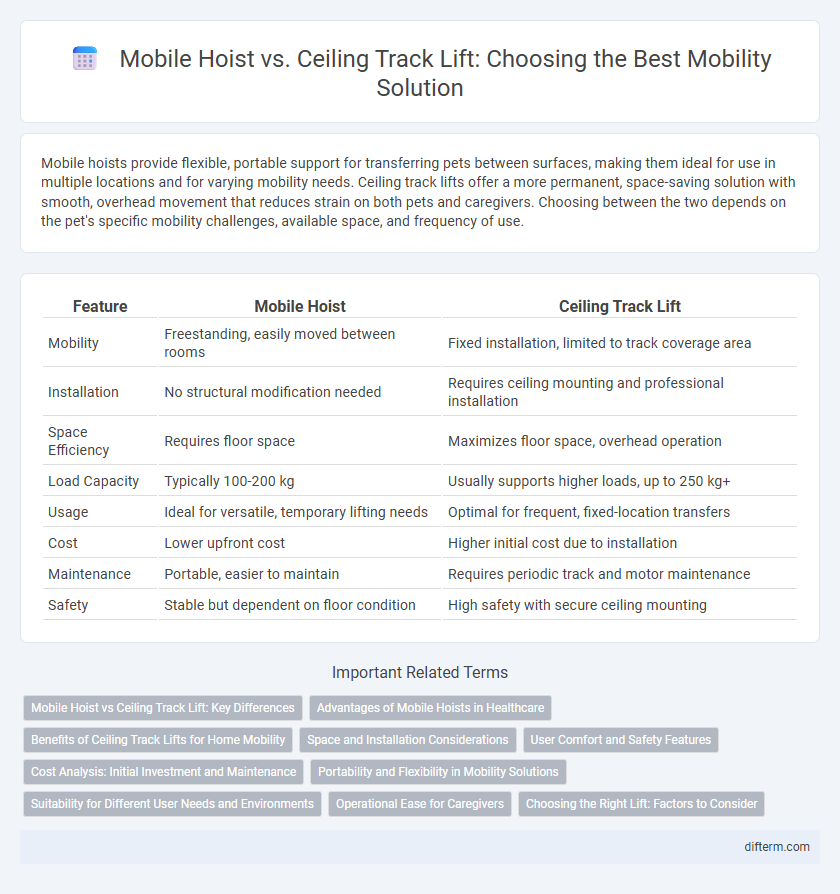Mobile hoists provide flexible, portable support for transferring pets between surfaces, making them ideal for use in multiple locations and for varying mobility needs. Ceiling track lifts offer a more permanent, space-saving solution with smooth, overhead movement that reduces strain on both pets and caregivers. Choosing between the two depends on the pet's specific mobility challenges, available space, and frequency of use.
Table of Comparison
| Feature | Mobile Hoist | Ceiling Track Lift |
|---|---|---|
| Mobility | Freestanding, easily moved between rooms | Fixed installation, limited to track coverage area |
| Installation | No structural modification needed | Requires ceiling mounting and professional installation |
| Space Efficiency | Requires floor space | Maximizes floor space, overhead operation |
| Load Capacity | Typically 100-200 kg | Usually supports higher loads, up to 250 kg+ |
| Usage | Ideal for versatile, temporary lifting needs | Optimal for frequent, fixed-location transfers |
| Cost | Lower upfront cost | Higher initial cost due to installation |
| Maintenance | Portable, easier to maintain | Requires periodic track and motor maintenance |
| Safety | Stable but dependent on floor condition | High safety with secure ceiling mounting |
Mobile Hoist vs Ceiling Track Lift: Key Differences
Mobile hoists offer flexible positioning and easy transport for patient transfers, while ceiling track lifts provide permanent installation with unobstructed floor space. Mobile hoists require more room for maneuvering and may need regular battery charging, whereas ceiling track lifts support seamless movement along fixed routes, improving safety and efficiency in frequent lift use. Choosing between the two depends on factors such as installation environment, frequency of use, and patient mobility needs.
Advantages of Mobile Hoists in Healthcare
Mobile hoists offer unmatched flexibility in healthcare settings by facilitating patient transfers without the need for fixed infrastructure, making them ideal for multi-room use and varied environments. Their portability enables caregivers to provide support wherever needed, enhancing patient comfort and reducing the risk of injury during transfers. These devices often require less space than ceiling track lifts, allowing for easier storage and maneuverability in tight or crowded healthcare facilities.
Benefits of Ceiling Track Lifts for Home Mobility
Ceiling track lifts offer enhanced mobility solutions by maximizing floor space and reducing trip hazards in home environments. Their fixed installation allows for seamless, reliable support during transfers, promoting safer and more efficient movement. With customizable track layouts, ceiling lifts accommodate various room sizes and user needs, providing superior accessibility compared to mobile hoists.
Space and Installation Considerations
Mobile hoists require minimal floor space and offer flexible repositioning without permanent fixtures, making them ideal for temporary or multi-room use. Ceiling track lifts demand professional installation with customized track layouts, maximizing floor space by utilizing overhead structures. Both options vary in installation complexity and spatial impact, with ceiling lifts better suited for permanent, space-saving solutions.
User Comfort and Safety Features
Mobile hoists provide flexible mobility and ease of use, featuring padded slings and adjustable frames that enhance user comfort during transfers. Ceiling track lifts offer superior stability and reduced risk of tipping, ensuring optimal safety by securely supporting users throughout movement. Both systems incorporate safety locks and smooth, quiet operation, prioritizing user well-being in various care environments.
Cost Analysis: Initial Investment and Maintenance
Mobile hoists typically require a lower initial investment compared to ceiling track lifts, as they do not necessitate structural modifications or complex installations. Maintenance costs for mobile hoists can be higher due to frequent relocation and potential wear on moving parts, while ceiling track lifts often incur lower long-term maintenance expenses owing to fixed installations and fewer mechanical components exposed to movement. Evaluating total cost of ownership involves balancing upfront expenses against ongoing maintenance and durability within the specific mobility requirements.
Portability and Flexibility in Mobility Solutions
Mobile hoists offer superior portability with their wheeled bases, enabling easy transport across different rooms and environments without installation constraints. Ceiling track lifts provide enhanced flexibility in mobility solutions by allowing seamless movement along fixed tracks tailored to specific room layouts, ideal for permanent setups. Choosing between mobile hoists and ceiling track lifts depends on the user's need for temporary mobility assistance versus long-term, stable transfer solutions.
Suitability for Different User Needs and Environments
Mobile hoists offer flexibility and portability, making them ideal for home care settings or environments requiring frequent repositioning of users. Ceiling track lifts provide permanent, unobtrusive installation suited for users with consistent transfer needs and limited mobility within a defined space. Both systems accommodate various user weights and mobility levels, but ceiling track lifts enhance room accessibility and reduce caregiver strain in long-term care facilities.
Operational Ease for Caregivers
Mobile hoists offer caregivers enhanced operational ease through their portability and straightforward setup, allowing flexibility to move patients across various locations without structural modifications. Ceiling track lifts streamline patient transfers by eliminating the need to maneuver around furniture, providing a hands-free, smooth lifting experience that reduces physical strain on caregivers. Both systems optimize workflow efficiency, but ceiling track lifts excel in fixed settings by enabling quicker, safer, and more ergonomic patient handling.
Choosing the Right Lift: Factors to Consider
When choosing between a mobile hoist and a ceiling track lift, consider factors such as space availability, frequency of use, and patient mobility needs. Mobile hoists offer flexibility and portability, ideal for settings requiring frequent repositioning or transfers. Ceiling track lifts provide a permanent solution with unobstructed floor space, enhancing safety and ease of movement for patients with limited mobility.
mobile hoist vs ceiling track lift Infographic

 difterm.com
difterm.com